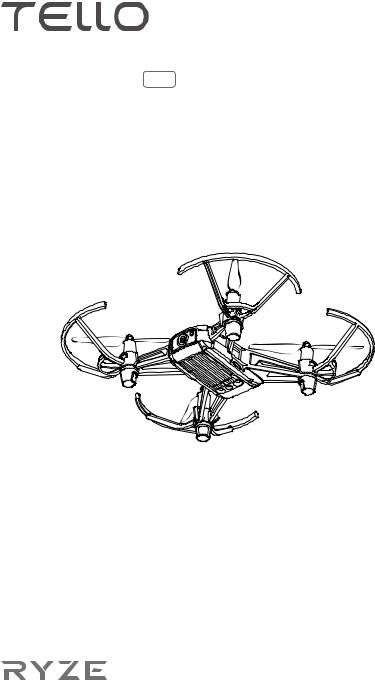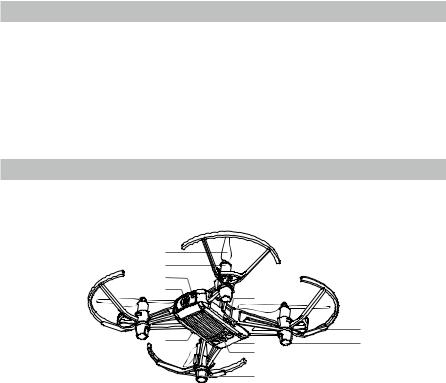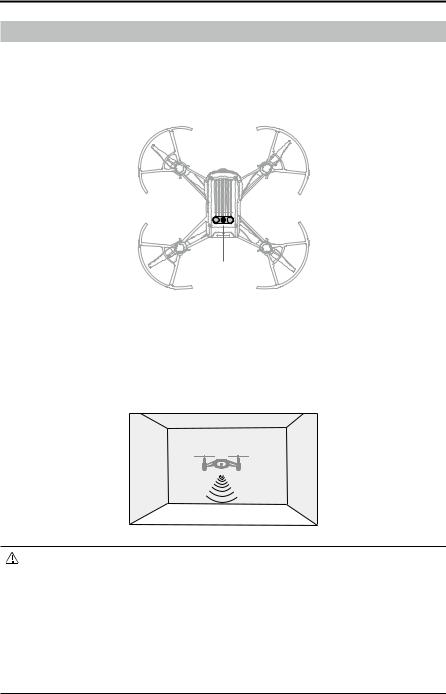DJI TELLO-EDU Users Manual

User Manual v1.4
2018.09

 Searching for Keywords
Searching for Keywords
Search for keywords such as “battery” and “install” to find a topic. If you are using Adobe Acrobat Reader to read this document, press Ctrl+F on Windows or Command+F on Mac to begin a search.
 Navigating to a Topic
Navigating to a Topic
View a complete list of topics in the table of contents. Click on a topic to navigate to that section.
 Printing this Document
Printing this Document
This document supports high resolution printing.
Using This Manual
Legend
Warning |
Important |
Hints and Tips |
Reference |
Read Before the First Flight
Read the following documents before using the TELLOTM:
1.Tello User Manual*
2.Tello Quick Start Guide
3.Tello Disclaimer and Safety Guidelines
We recommend that you watch all tutorial videos on the official RYZE Tech website https://www. ryzerobotics.com/tello and read the Tello Disclaimer and Safety Guidelines before you fly. Prepare for your first flight by reviewing the Tello Quick Start Guide and refer to this Tello User Manual for more details.
Download the Tello App
Search for “Tello” on the App Store or Google Play or scan the QR code on the right to download the latest version of the app. The Android version of the Tello app is compatible with Android v4.4 and later. The iOS version of the Tello app is compatible with iOS v9.0 and later.
Units of Measurement
This product is designed and tested using metric units. For user convenience US units are also provided in this manual. Figures quoted in US units are conversions from metric units. In some cases they are approximate and they are sometimes rounded to make it easier for users to comply with safety guidelines. All figures quoted in US units should be taken for reference only.
* Tello user manual applies to all Tello aircrafts, including Tello and Tello Edu aircraft.
2 © 2018 Ryze Tech. All Rights Reserved.
Contents
Using This Manual |
2 |
Legend |
2 |
Read Before the First Flight |
2 |
Download the Tello App |
2 |
Units of Measurement |
2 |
Product Profile |
4 |
Introduction |
4 |
Aircraft Diagram |
4 |
Aircraft |
5 |
Flight Modes |
5 |
Aircraft Status Indicator |
6 |
Vision Positioning System |
7 |
Intelligent Flight Modes |
8 |
Propellers |
12 |
Propeller Guards |
13 |
Flight Battery |
14 |
Camera |
15 |
Tello App |
16 |
Connecting to the Aircraft |
16 |
Camera View |
16 |
Controlling the Aircraft |
17 |
Flight |
20 |
Flight Environment Requirements |
20 |
Compliance with Regulations |
20 |
Test Flight |
20 |
Firmware Updates |
21 |
Specifications |
21 |
After-Sales Information |
21 |
© 2018 Ryze Tech. All Rights Reserved. 3

Product Profile
Introduction
Tello is a small quadcopter that features a Vision Positioning System and an onboard camera. Using its Vision Positioning System and advanced flight controller, it can hover in place and is suitable for flying indoors. Advanced features like Bounce mode, 8D Flips, and EZ Shots make using Tello fun. Tello captures 5 megapixel photos and streams 720p live video to the Tello app on a mobile device. Its maximum flight time is approximately 13 minutes*, and its maximum flight distance is 328 ft (100 m).
Failsafe Protection enables Tello to land safely even if you lose connection and its propeller guards can be used to enhance safety.
Aircraft Diagram
1 |
|
|
2 |
|
|
3 |
|
|
4 |
9 |
|
|
|
|
5 |
|
10 |
8 |
6 |
|
|
7 |
|
|
6 |
|
1.Propellers
2.Motors
3.Aircraft Status Indicator
4.Camera
5.Power Button
6.Antennas
7.Vision Positioning System
8.Flight Battery
9.Micro USB Port
10.Propeller Guards
* Maximum flight time was tested in windless conditions flying at a consistent 9 mph (15 kph). This value should be taken for reference only.
4 © 2018 Ryze Tech. All Rights Reserved.

Aircraft
The Tello contains a flight controller, video downlink system, Vision Positioning System, propulsion system, and a Flight Battery. Refer to the aircraft diagram in the Product Profile section.
Flight Modes
The Tello can be controlled manually using the virtual joysticks in the Tello app or using a compatible remote controller. It also has various Intelligent Flight Modes that be used to make Tello perform maneuvers automatically. In addition, the Tello has a flight mode that it falls back to in certain circumstances.
The Intelligent Flight Modes are described in detail in the separate Intelligent Flight Modes section. The Aircraft Status Indicator section describes how the Aircraft Status Indicator provides an indication of which mode the aircraft is in.
Flying the Tello Manually
The Tello has two flight speeds that you can select when flying the aircraft manually:
•Slow (default): The maximum flight attitude angle is 9° and the maximum flight speed is 6.7 mph (10.8 kph).
•Fast: The maximum flight attitude angle is 25° and the maximum flight speed is 17.8 mph (28.8 kph).
When flying the Tello manually the aircraft utilizes its Vision Positioning System to automatically stabilize itself. If the conditions are such that the Vision Positioning System is unavailable the aircraft automatically changes to Attitude mode.
• To switch from Slow to Fast you must read and agree to the disclaimers and warnings that appear in the Tello app. Make sure you understand the differences between the two flight speeds.
• Failsafe Protection automatically initiates landing if the mobile device's signal is weak or is lost for 50 seconds, or the Tello app crashes.
In the Tello app the flight speed is selected in the settings screen.
Attitude Mode
The aircraft automatically changes to Attitude mode (ATTI mode) when the Vision Positioning
System is unavailable. In Attitude mode the aircraft is not able to position itself and so is easily affected by its surroundings. Environmental factors such as wind can result in horizontal shifting, which may present hazards, especially when flying in confined spaces. When the aircraft enters
Attitude mode, land in a safe place as soon as possible to avoid hazards.
The Aircraft Status Indicator blinks yellow slowly when the aircraft is in Attitude mode.
© 2018 Ryze Tech. All Rights Reserved. 5

TELLO User Manual
Aircraft Status Indicator
The Tello’s Aircraft Status Indicator communicates the statuses of the aircraft’s flight control system and Flight Battery. The Aircraft Status Indicator is located on the aircraft’s nose, next to the camera, as shown in the figure below. Refer to the table below for more information about the aircraft states indicated by the Aircraft Status Indicator.
Aircraft Status Indicator States
Normal States |
Color |
Pattern |
Aircraft State |
|
Alternating red, |
|
Turning on and performing self- |
||
|
Blinking |
|||
|
green, and yellow |
diagnostic tests |
||
|
Periodically blinks |
|||
|
Green |
Vision Positioning System active |
||
|
|
twice |
Vision Positioning System |
|
|
|
|
||
|
Yellow |
Blinking slowly |
unavailable, aircraft is in Attitude |
|
Charging States |
|
|
mode |
|
Blue |
Solid |
Charging is complete |
||
|
||||
|
Blue |
Blinking slowly |
Charging |
|
Warning States |
Blue |
Blinking quickly |
Charging error |
|
Yellow |
Blinking quickly |
Remote control signal lost |
||
|
||||
|
Red |
Blinking slowly |
Low battery |
|
|
Red |
Blinking quickly |
Critically low battery |
|
|
Red |
Solid |
Critical error |
6 © 2018 Ryze Tech. All Rights Reserved.

TELLO User Manual
Vision Positioning System
The Vision Positioning System helps the aircraft maintain its current position. With the help of the Vision Positioning System, the Tello can hover in place more precisely and fly indoors or outdoors in windless conditions. The main components of the Vision Positioning System are a camera and a 3D infrared module located on the underside of the aircraft.
Vision
Positioning
System
Using the Vision Positioning System
The Vision Positioning System is activated automatically when the aircraft is turned on. No further action is required. The Vision Positioning System is only effective when the aircraft is at altitudes of 1.0 to 98.4 ft (0.3 to 30 m) and works best at altitudes of 1.0 to 19.7 ft (0.3 to 6 m). If the aircraft is beyond this range, the Vision Positioning function may be affected, so extra caution is required.
• The performance of the Vision Positioning System is affected by the surface being flown over. The aircraft automatically changes to Attitude mode when the Vision Positioning
System is unavailable. In Attitude mode the aircraft is not able to position itself. Operate the aircraft with great caution in the following situations, which may cause the aircraft to enter Attitude mode:
a.Flying at high speed below 2 ft (0.5 m).
b.Flying over monochrome surfaces (e.g. pure black, pure white, pure red, pure green).
c.Flying over highly reflective surfaces.
d.Flying over water or transparent surfaces.
e.Flying over moving surfaces or objects.
© 2018 Ryze Tech. All Rights Reserved. 7
